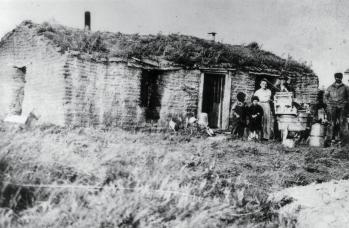

The transition of the Canadian West from native prairie and parkland to a surveyed, fenced, and densely populated agricultural economy occurred in a remarkably short period of time. The resulting clash of cultures, ideologies, languages, politics, and ways of life has reverberated through and defined much of the first century of Saskatchewan's history. Both the myth and the reality of pioneer life, including all its variations and its reckoning of winners and losers, come to shape a part of the provincial identity. Pioneering in Saskatchewan involves the essentially agricultural concept of breaking the land, growing crops and building farms - and by extension, concentric circles of settlement: communities (roads, schools, halls, clubs, health care facilities and other services), municipalities, and eventually a provincial identity. The physical, emotional, and social demands of this concept were different in each area of the province, depending on the environment (grassland, parkland, or forest fringe) and the ethnic makeup of each community. As a result, the pioneering stage of each area came earlier or later depending on immigration and ethnic bloc settlement patterns, railway, and homestead development. The earliest homesteads on the open grasslands of southeastern Saskatchewan were developed as much as fifty years ahead of the pioneering phase of the forest fringe and bush land north of the North Saskatchewan River during the 1920s and 1930s. Changes in agricultural techniques and implements, transportation, political infrastructure and social arrangements combined with geographic issues to produce unique pioneering experiences across the province.
Deconstructing the pioneer experience is a complex undertaking. First and foremost is the need to recount the realities of pioneer life. Stories of isolation, loneliness, brutal climatic extremes, and unbearably hard work are commonplace. At the same time, stories about devastation and setbacks, racism, starvation and death are intertwined with stories of co-operating and community building, community spirit, local culture, recreation, arts, music, dance, fairs and merriment. Taking the homestead bet and breaking land, sometimes hundreds of miles from established cities or railheads, meant that pioneers had to rely on their own resources. Everything from food, shelter, and clothing to medical and spiritual needs, economic interests, social and cultural activities had to be created using the tools at hand. However, common experiences were evident, despite differences of race, gender or ethnicity. These experiences necessitated a spirit of neighbourliness and community creation, as people worked together towards common goals or helped each other in times of stress and hardship. This dual narrative of the pioneer life - hard times, but good times - is instantly recognizable and has led to the creation of an archetypical pioneer figure in popular culture.
This pioneer myth is a universal figure with identifiable characteristics. Words such as rugged, stalwart, honest, hardworking, entrepreneurial, moral, hopeful, resourceful, and visionary are used to describe a pioneer. It is an inclusive and encompassing myth, as most people can find a pioneer within their genealogical heritage. Moreover, it has been popularly used to describe those who are the first to do a particular job: the first doctors, lawyers, storekeepers, livery barn owners, blacksmiths, nurses, or teachers are all considered pioneers. However, the myth includes only those who were victorious in their pioneer gamble. People who attempted the pioneer life and found it lacking or were defeated by it, are not part of the myth, although their tribulations provide much of the adverse situations required to create the symbolic heroism.
Pioneer symbolism can be successfully applied to persons regardless of gender or ethnicity, with the glaring exception of Aboriginal people. The pioneer narrative and myth assumes that Aboriginal people are either pre-pioneer historical figures or merely irrelevant. The decline of many rural Saskatchewan communities since World War II has produced a flood of published histories that proudly tell about the pioneer era “before they are lost.” The few pages devoted to Aboriginal history focus primarily on pre-contact, not current, Native life. Although there are variations, these history books are essentially tools used to identify and celebrate individual communities. The idea of home and community creation on the frontier, of building something from nothing, is an integral part of the pioneer story. It is also the main vehicle by which non-Aboriginal Saskatchewan residents legitimize their presence in this province. By telling and retelling the stories of the pioneers, local and academic historians along with writers, storytellers, artists, musicians, and politicians have used the pioneer narrative to explain and legitimize concepts of progress, prosperity, economic opportunity and community creation - all of which are contingent upon the absence of Aboriginal people.
Merle Massie